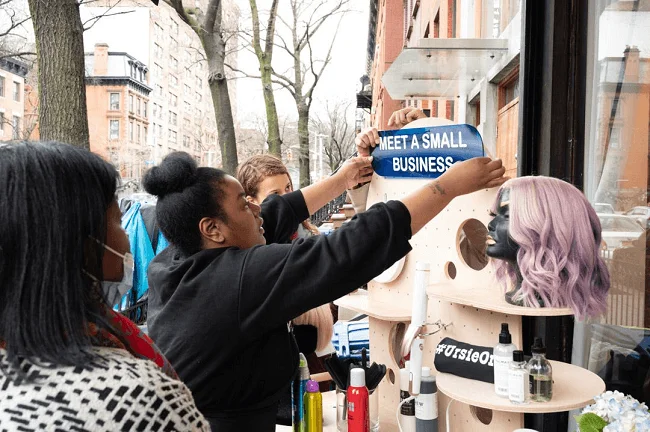The lines between digital and physical are getting more and more blurred all the time. In fact, the augmented and virtual reality market in the US is projected to grow into an almost $18 billion dollar industry in the next 5 years. This means that companies need to start now to ensure their online and offline experiences are seamlessly interwoven. And honestly, if you’re just starting now, you’re already behind so the time is now to get caught up… and quickly!
A few years ago I made an online purchase with H&M. Since they are a massive global brand, I made the assumption I could buy several items online, try them on at home and return or exchange whatever didn’t work in-store. Turns out, at that time, they had the online store and the physical stores running as two separate companies so they couldn’t allow online purchase returns in the stores. Hearing this, I wondered why such a massive company was creating a major friction point for their customers when the actual financial behind-the-scenes was a “them” problem and really should not have affected their customers. They have since corrected the issue but for quite a while, I wouldn’t buy online from H&M, which means they lost out on sales. And if they weren’t the company they are, I would have found somewhere else to shop and they would have lost a customer for good.
As a small business, you can’t afford to be leaving sales on the table or to be hurting your brand reputation by creating this type of friction. Your customers need to be able to start their shopping online, because that’s how almost 90% of your sales will start, and move seamlessly into your physical location. This is as simple as online ordering with in-store pick up that runs smoothly and gets it right or it can be as complex as using AR or VR to allow a customer to “try on”, preview or build-your-own before they come into the store to make a purchase. Having this type of option right in your store so they can shop digitally in your brick and mortar location is even better too.
Allowing customers to transition from online to in-store seamlessly requires bullet-proof processes and policies (that are the same across all platforms), as well as impeccable employee training. Your customer-facing teams all need to be on the same page and aware of what’s happening online and in any marketing you’re putting out there. You also want to give your team the autonomy to adjust where they need to when an error is made so that the customer is not the one who feels or pays the price for any glitches in the system.
Customer experience is about delighting your customer as frequently as possible. You don’t want them to leave simply feeling okay about their purchase or choice to do business with you. You want them to feel as though they had an exceptional experience they cannot get elsewhere more easily. Removing friction points to allow access across multiple channels that all interconnect with their physical experience is crucial to success as we move into a more digitized era.
Here are some simple tips for small businesses to make this happen without complicated technology.
-
Consider using QR codes instead of price tags. You can share much more detailed information, promos, inventory, purchase and return policies, previous customer reviews and much more. QR codes can also load videos that tell the customer more about the product or about your brand.
-
If your product requires a “try-on” or test drive such as clothing, household items, vehicles, a new smile or set of brows, it may be well worth creating an app or digital experience that uses AR or VR to allow the customer to see what the new item will look like before they take the next steps.
-
Create 3D models of your products and have them available on your website. That way a customer knows exactly what they are buying from multiple angles and can often be certain of their purchase before they visit you. They can also check out all of the different colour, style and size options available as well. This cuts down on the time they spend in-store which may also save you time and money on staffing. Even high resolution photos that can be zoomed in on to see details are a great starting point.
-
Give your customers options when it comes to buying, contacting you and deciding which options work best for them. Allow them to buy online or in-person, to contact you via chat, email, phone or social media and give them choices. People want convenience and you can’t possibly know what’s most convenient for them, so options it is.
-
Provide flexible options that allow customers to buy online, try and return or exchange easily either online or in-store. If customers don’t have to come into your store to purchase, but you eliminate the fear associated with taking that risk by offering risk-free returns, you are certain to increase sales in the long run.
-
Continue the conversation with your customers after their purchase by using email marketing campaigns to keep in touch. Send personalized product recommendations, care tips, tutorial videos, review requests, special offers, renewal reminders and loyalty rewards. Ensure they can be used online and offline.
The goal is to allow your customers to interact with the product or service, see it from different angles, evaluate the texture or look it will create or place it in context in a room or on their body. It is also to ensure that what is experienced online can be found when the customer visits your store in person. And that what they experience is consistent no matter where they find you.
And don’t forget, equally important is seamlessly following your customer back online once they leave your physical location. Emailed receipts and contracts, follow up check ins, usage tips, additional offers to support their purchase and much more can be triggered when they buy. This is an excellent way to keep in touch with your customers, encourage repeat purchases and advocacy and create new business opportunities, all while doing what is genuinely best for your customers and gives them an excellent experience.
The case for providing an experience that can move seamlessly online to offline and back online again is clear: customers expect it and the data shows sales and brand loyalty increase when you execute this type of customer experience well.
Ensure your entire end to end processes are in sync and that your team is all on board with the execution. Consistency is the key to truly creating lasting trust that will delight your customers and keep them coming back over and over again.
If you need help creating online experiences that integrate with your in-store experience, we can help. Reach out to chat about the unique ways we can bring your brand to life digitally!





